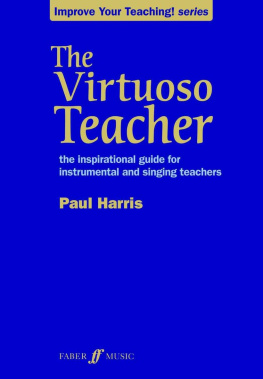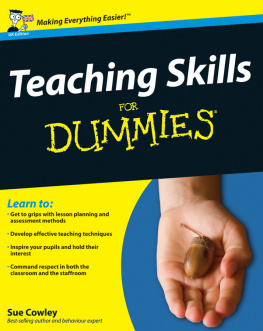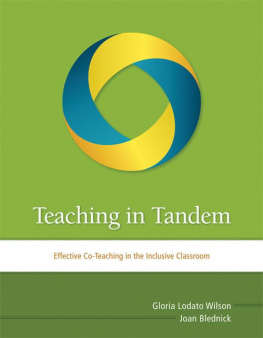Of all the qualities Virtuoso Teachers possess, I have no doubt that the greatest is a desire to share, unconditionally, their enthusiasm and skill. I was fortunate enough to have been taught by more than one Virtuoso Teacher during my musical education and I am also very privileged to know a good number of such teachers. I couldnt have written this book without their help and support and would like to mention some special ones, who have spent many hours discussing teaching with me and who have commented generously on the text they are Virtuoso Teachers all: my own teacher and mentor, Professor John Davies, Sally Adams, Dr. Timothy Bowers, Rupert Burchett, Jean Cockburn, Richard Crozier, Simon Dearsley, Simon Grew, David Hargreaves, Graeme Humphrey, Diana Jackson, Tim Jones, Helen Leek, Brian Ley, Adam Ockelford, Ann Priestley, Melanie Ragge and Robert Tucker. There are other friends and pupils who have helped in the research huge thanks to them, too, and especially to the pupils of Beachborough School, The Royal Latin School and the Worcestershire Music Service. And, as ever, the exceptional team at Faber Music: Richard King, Kathryn Knight, Leigh Rumsey and, especially Lesley Rutherford, a true virtuoso among editors huge thanks to all.
Foreword
Creating a virtuoso, as we understand it, usually conveys an image of a teacher honing the skills of a gifted apprentice moving towards a brilliant career. Paul Harris boldly extends this notion, embarking on a ground-breaking trek to identify the path towards virtuosic teaching. In fact, the criteria for virtuosity turns out to be broadly similar for the pedagogue as for the wunderkind; namely brilliant communication, technical flair and artistic leverage.
Pauls indefatigable mission to raise the stakes for teachers and teaching is articulated here in his most complete and turbo-charged study to date. He builds on clarity and trust as core values (such is his enthusiasm you sense a quiet bafflement that teaching is not regarded by everyone as the most thrilling of pursuits), supported by an irrepressible imagination. Paul believes that practical, intuitive and reflective processes, in tandem, can bring renewed currency to the art of teaching at its most virtuosic.
Fascinatingly, Paul Harriss sense of virtuosity eschews all the ostentation we often associate with the word. This is a deliberate ploy and allows the reader to craft for himself what is needed to become a thoughtful, effective and multi-dimensional teacher. Whilst a strong philosophical thread runs through this cornucopia of teaching practice, expert navigation constructively supports practical methods that are both realisable and realistic for any teacher willing to open their minds. There are some experimental suggestions that might not work for everyone, but Paul Harris never espouses one-size-fits-all since he recognises that teaching is an intangible journey of independent discovery.
Yet there are non-negotiable elements, the sound principles which inhabit all good teaching knowing your pupils, always questioning the motivation for learning and teaching, using the power of personal example and imitation and understanding that both parties simultaneously bring new interest and perspective to proceedings each fuelled by the need to instil hope and confidence at every turn.
Paul Harris never pretends that this is an easy journey. What virtuosity ever landed on a plate? The magic conveyed here is about delighting in the endless potential of Pauls techniques and approaches, leading to a mutual gain enjoyed by master and apprentice and the durable resonances of inspired teaching. This book is a virtuoso performance in its own right.
Professor Jonathan Freeman-Attwood
Principal, Royal Academy of Music
Love of learning is akin to wisdom.
Confucius
Being a virtuoso
It was George Bernard Shaw in his play Man and Superman who coined the fateful expression we all know as:Those who can, do; those who cant, teach .The phrase has never been forgotten. Shaw should be ashamed of himself! Well, its time to put that well and truly behind us.
Heres a version for the twenty-first century: those who can, do; those who can do better than those who just do, teach.
There is a belief that teaching is indeed a bit of a second-class act. It isnt. It may become so if approached with a second-class attitude, but if we desire to do the job really well then that status soon changes teaching is an enormously important profession which should always enjoy seriously high standing in society. Teaching is, indisputably, a wonderful, fulfilling, endlessly stimulating and hugely responsible occupation. And, just as we can aspire to be a virtuoso player, we can also aspire to be a Virtuoso Teacher.
Virtuoso Teachers are not virtuoso players who teach, though the virtuoso player may aspire to become a Virtuoso Teacher! Neither are they teachers who may teach the occasional virtuoso.
Virtuoso Teachers teach as the virtuoso player plays: with a heightened sense of awareness, with passion and energy, with profound involvement and genuine commitment. Virtuoso Teachers teach everyone who wants to learn (from beginners upwards) in such a way that their pupils really do learn and really do benefit from the teaching and, as a result, dont give up prematurely . Anyone can become a Virtuoso Teacher. It doesnt take long to make the transition. We just have to be determined, dedicated, and prepared to spend quality time thinking and reflecting on our work.
All young people should have the opportunity to receive teaching that ultimately gives them the confidence and ability to access the marvellous world of music entirely independently and at any level. That is what the Virtuoso Teacher does.
The spirit of Paganini
Paganini was perhaps the most famous of all virtuosi. So what were the qualities that caused people to endure many miles of travel (in the days when travel really was quite an undertaking) and to be in their seats hours before his performances? We can put this success down to three qualities: great communication skills, an exceptional technique, and a mesmerising artistry and imagination.
The Virtuoso Teacher aspires to exactly these same qualities:
Communication skills help us connect with our pupils and spur them on to fulfil their musical dreams.
Technique born from the knowledge and strategies we use to help our pupils develop their playing and singing, and which we can practise just as the virtuoso player does. This technique reaches far beyond our knowledge of repertoire or how to operate the instrument and forms much of what this book considers.








